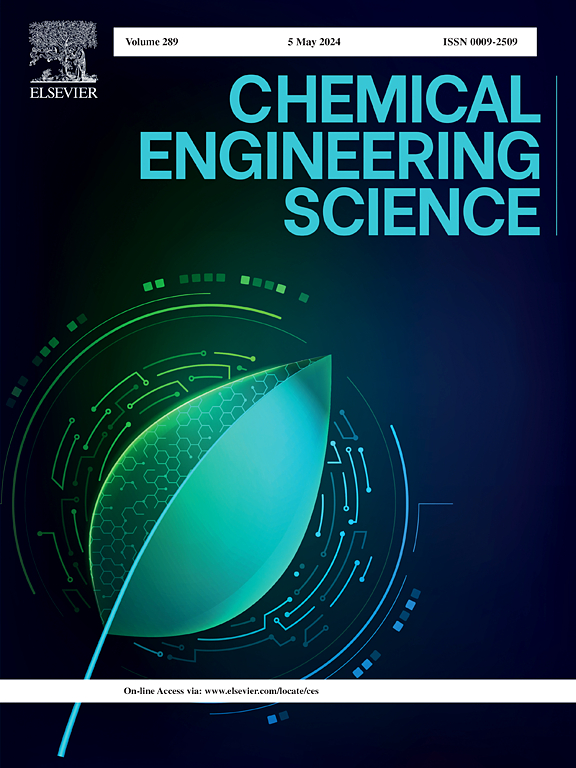Microscopic insights into the synergic promotion of hydrate formation by tetrabutylammonium bromide and CO2 for gas and energy storage by molecular dynamics
IF 4.1
2区 工程技术
Q2 ENGINEERING, CHEMICAL
引用次数: 0
Abstract
CO2 clathrate hydrate has emerged as a promising carbon and energy storage materials due to its high gas storage capacity (160–180 V V−1) and latent heat (374 kJ kg−1). The tetrabutylammonium bromide (TBAB) is used to thermodynamically promote CO2 hydrate formation through forming double CO2 + TBAB hydrate whose molecular structure combines characteristics of both clathrate hydrate and semi-clathrate hydrate. Molecular dynamic simulations are employed to attain microscopic insights into the hydrate growth and CO2 encaging mechanisms of double CO2 + TBAB hydrate. The results indicate that small 512 cages initially form on the surface of TBAB semi-clathrate hydrate, simultaneously encaging CO2 molecules. Notably, these encaged CO2 molecules can further migrate into inner empty 512 cages to enhance CO2 absorption. The double hydrate formation is regulated by the two distinct types of guest molecules (CO2/TBAB) through influencing the formation and stability of hydrate cages. Compared to pure CO2 clathrate hydrate, the TBAB semi-clathrate cage provides 512 cages that can encage CO2 molecule under milder conditions. Additionally, the presence of CO2 promotes the formation of 512 cage, thereby enhancing the hydrate growth rate. Thus, TBAB and CO2 molecules show synergic promoting effects on the growth of double CO2 + TBAB hydrate. The results clarify the correlation between cage occupancy ratio at micro-scale and cold storage capacity of CO2 + TBAB hydrate at macro-scale. Specifically, a higher 512 cage occupancy ratio leads to larger latent heat and cold storage capacity. The results corroborate the macroscopic properties observed experimentally regarding CO2 absorption and cold storage performance of double CO2 + TBAB hydrate where the latent heat increases from 284.8 kJ kg−1 to 298.3 kJ kg−1 as cage occupancy ratio rises from 0.62 to 0.72. These findings can assist in devising optimal production strategies for cold energy storage and CO2 absorption.四丁基溴化铵和二氧化碳协同促进水合物形成的微观见解,通过分子动力学进行气体和能量储存
CO2包合物水合物具有较高的储气能力(160-180 V V−1)和潜热(374 kJ kg−1),是一种很有前途的储碳和储能材料。四丁基溴化铵(TBAB)通过形成双CO2来热力学促进CO2水合物的形成 + TBAB水合物,其分子结构结合了包合物水合物和半包合物水合物的特征。采用分子动力学模拟方法对双CO2 + TBAB水合物的水合物生长和CO2包封机理进行了微观研究。结果表明:TBAB半笼型水合物表面最初形成了小的512笼,同时包裹CO2分子;值得注意的是,这些被包裹的CO2分子可以进一步迁移到内部空的512笼中,以增强CO2的吸收。两种不同类型的客体分子(CO2/TBAB)通过影响水合物笼的形成和稳定性来调节双水合物的形成。与纯CO2包合物水合物相比,TBAB半包合物笼提供了512个笼,可以在更温和的条件下包裹CO2分子。另外,CO2的存在促进了512笼的形成,从而提高了水合物的生长速度。因此,TBAB和CO2分子对双CO2的生长表现出协同促进作用 + TBAB水合物。研究结果阐明了微观尺度上笼占率与宏观尺度上CO2 + 水合物TBAB冷库容量的相关性。具体而言,512笼占用率越高,潜热和冷库容量越大。结果证实了实验观察到的双CO2 + TBAB水合物的CO2吸收和冷藏性能的宏观特性,当笼内占用率从0.62增加到0.72时,潜热从284.8 kJ kg−1增加到298.3 kJ kg−1。这些发现有助于设计冷能量储存和二氧化碳吸收的最佳生产策略。
本文章由计算机程序翻译,如有差异,请以英文原文为准。
求助全文
约1分钟内获得全文
求助全文
来源期刊

Chemical Engineering Science
工程技术-工程:化工
CiteScore
7.50
自引率
8.50%
发文量
1025
审稿时长
50 days
期刊介绍:
Chemical engineering enables the transformation of natural resources and energy into useful products for society. It draws on and applies natural sciences, mathematics and economics, and has developed fundamental engineering science that underpins the discipline.
Chemical Engineering Science (CES) has been publishing papers on the fundamentals of chemical engineering since 1951. CES is the platform where the most significant advances in the discipline have ever since been published. Chemical Engineering Science has accompanied and sustained chemical engineering through its development into the vibrant and broad scientific discipline it is today.
 求助内容:
求助内容: 应助结果提醒方式:
应助结果提醒方式:


